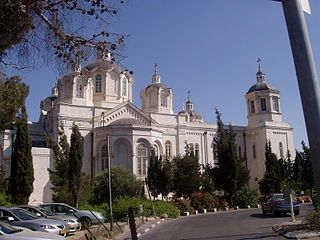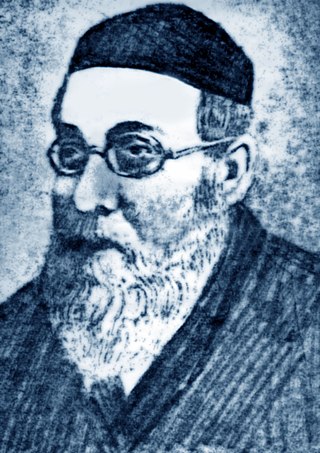
Kerem Avraham, in English Abraham's Vineyard, is a neighbourhood near Geula in central Jerusalem, founded in 1855. It is bounded by Malkhei Yisrael Street, Yechezkel Street, Tzefanya Street, and the Schneller Compound.

Jerusalem's population size and composition has shifted many times over its 5,000 year history.

Mishkenot Sha'ananim was the first Jewish settlement built outside the walls of the Old City of Jerusalem, on a hill directly across Mount Zion. It was built in 1859–1860. This guesthouse was one of the first structures to be built outside the Old City, the others being Kerem Avraham, the Schneller Orphanage, Bishop Gobat school, and the Russian Compound.

The perushim were Jewish disciples of the Vilna Gaon, Elijah ben Solomon Zalman, who left Lithuania at the beginning of the 19th century to settle in the Land of Israel, which was then part of Ottoman Syria. They were from the section of the community known as misnagdim in Lithuania.

The Russian Compound is one of the oldest districts in central Jerusalem, featuring a large Russian Orthodox church, the Russian-owned Sergei's Courtyard and the premises of the Russian Consulate General in Jerusalem, as well as the site of former pilgrim hostels, some of which are used as Israeli government buildings, and one of which hosts the Museum of Underground Prisoners. The compound was built between 1860 and 1890, with the addition in 1903 of the Nikolai Pilgrims Hospice. It was one of the first structures to be built outside the Old City of Jerusalem. The Bezalel Academy of Arts and Design's main campus is adjacent to the compound.

Yemin Moshe is a historic neighborhood in Jerusalem, overlooking the Old City.

Jerusalem University College is an independent undergraduate and graduate academic institution in Israel used by a consortium of North American theological seminaries and Christian colleges.

Nachlaot is a cluster of 23 courtyard neighborhoods in central Jerusalem surrounding the Mahane Yehuda Market. It is known for its narrow, winding lanes, old-style housing, hidden courtyards and many small synagogues.

Geula is a neighborhood in the center of Jerusalem, populated mainly by Haredi Jews. Geula is bordered by Zikhron Moshe and Mekor Baruch on the west, the Bukharim neighborhood on the north, Mea Shearim on the east and the Jerusalem city center on the south.

The Montefiore Windmill is a landmark windmill in Jerusalem. Designed as a flour mill, it was built in 1857 on a slope opposite the western city walls of Jerusalem, where three years later the new Jewish neighbourhood of Mishkenot Sha'ananim was erected, both by the efforts of British Jewish banker and philanthropist Moses Montefiore. Jerusalem at the time was part of Ottoman-ruled Palestine. Today the windmill serves as a small museum dedicated to the achievements of Montefiore. It was restored in 2012 with a new cap and sails in the style of the originals. The mill can turn in the wind.

This article deals in more detail with some of the notable synagogues of Jerusalem that do not have their own page as yet.

Schneller Orphanage, also called the Syrian Orphanage, was a German Protestant orphanage that operated in Jerusalem from 1860 to 1940.
Avraham Wolfensohn (1783–1855) was a Jewish rabbi, Talmudic judge and leader of the Ashkenazi community in Safed, Ottoman Galilee in the mid-19th century.

Mahane Israel is the second Jewish neighborhood built outside the walls of the Old City of Jerusalem after Mishkenot Shaananim.

Knesset Yisrael, also known as Knesset, is the name of a group of three former courtyard neighborhoods in central Jerusalem. Known as Knesset Aleph, Knesset Bet, and Knesset Gimmel, the housing project was planned by the Vaad HaKlali Knesset Yisrael and funded by overseas Jewish donors. The houses were completed in stages from 1892 to 1926. Beneficiaries of the housing were poor Haredi Ashkenazi families and Torah scholars connected to the Central Committee kolel system. Today Knesset Yisrael is part of the Nachlaot neighborhood.

Even Yisrael is a former courtyard neighborhood in Jerusalem. Built in 1875, it was the sixth Jewish neighborhood to be established outside the Old City walls. It is now part of the Nachlaot neighborhood. In 2004 the neighborhood underwent preservation and renovation by the Jerusalem Municipality, which re-paved and re-landscaped the central courtyard and added a small stone amphitheater for tour groups and daytime passersby.

Zikhron Tuvya, also spelled Zichron Tuvia, is a former courtyard neighborhood in Jerusalem. Founded in 1890, it was the twenty-third Jewish neighborhood to be established outside the Old City walls. The neighborhood consisted of parallel row-houses facing each other across a wide street, today named Zikhron Tuvya Street. Initially populated by tradesmen and workshops, it became a residential neighborhood after the 1920s. It is now part of the larger Nachlaot neighborhood.

Yosef Yitzhak "Yoshya" Rivlin was an Orthodox Jewish scholar, writer, and community leader in the Old Yishuv of Jerusalem. Scion of a family of Perushim, disciples of the Vilna Gaon who immigrated to Israel in the early 19th century, Rivlin spearheaded the establishment of the first Jewish neighborhoods outside the Old City walls. He helped found a total of 13 neighborhoods, beginning with Nahalat Shiv'a and Mea Shearim. His activities earned him the nickname Shtetlmacher ("Town-Maker"). He directed the Central Committee of Knesseth Israel, the supreme council of the Ashkenazi community in the Old Yishuv, for over 30 years.

Mahane Yehuda is a historic neighborhood in Jerusalem. Established on the north side of Jaffa Road in 1887, it was planned and managed by the consortium of Swiss-Christian banker Johannes Frutiger and his Jewish partners, Joseph Navon and Shalom Konstrum. By the end of the 19th century, it encompassed 162 homes. Originally occupied by upper middle-class residents, it became a working-class neighborhood beginning in the late 1920s. Today the neighborhood is part of Nachlaot. The Mahane Yehuda Market located across the street was named after the neighborhood.
Yitzhak Eliyahu Michal HaCohen was a publisher and a journalist. He was one of the co-founders of Nahalat Shiv'a, one of the first Jewish neighborhoods built outside the walls of the Old City of Jerusalem, and of HaLevanon, the first Hebrew language newspaper established in Jerusalem and published in Palestine.























